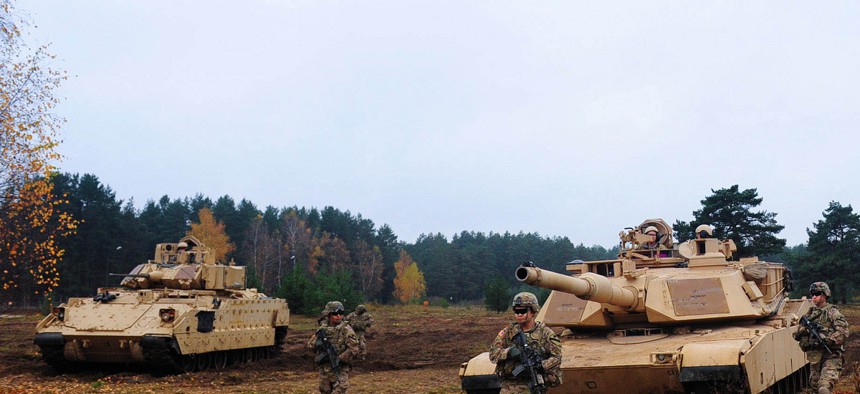
Soldiers assigned to the 1st Brigade Combat Team from Ft. Hood, Texas, demonstrate the capabilities of their vehicles at Military Base Adazi, Latvia. U.S. Army photo by Sgt. Daniel Cole
Army Fights Budget Cuts While Industry Targets Europe
After more than a decade of war, the Army is planning to buy less stuff, while defense firms are courting Europe in the wake of Ukraine. By Marcus Weisgerber
Uniformed and civilian leaders have used the annual Association of the United States Army convention in Washington, D.C.—attended by tens of thousands of soldiers and defense contractors—to warn of looming cuts, which experts say will likely remain in place for the foreseeable future.
But as the Army digs in for the budget fight, defense companies have used the event to pitch their products to visiting international delegations, including many from Europe.
The Army is expected to take the hardest hit from planned budget reductions as it cuts tens of thousands of soldiers from its ranks following more than a decade of large-scale ground battles in Afghanistan and Iraq.
The Air Force and Navy are expected to play a greater role in the Pentagon’s Pacific-focused pivot than the Army. The Air Force also has a number of looming acquisition programs, including a new bomber, jet trainer and combat search-and-rescue helicopter.
The same cannot be said for the Army, which had to cancel its $29 billion Ground Combat Vehicle program, leaving only two smaller vehicle programs on the horizon.
Assistant Secretary of the Army for Acquisition, Logistics, and Technology
“What we had to sacrifice on Ground Combat Vehicle was due to sequestration,” said Heidi Shyu, assistant secretary of the Army for acquisition, logistics, and technology. “It wasn’t the fact that we changed the requirement; it wasn’t the fact that the program contractor failed to deliver. It was the fact that we had a budget cut so significant, we had to give up billions of dollars.”
The typically soft-spoken Shyu got fired up when asked about the Army’s plans to modernize itself. She said the cancelation of the Ground Combat Vehicle project was “not a decision the Army wanted to make” and stressed a requirement for the new vehicle still exists.
And the other vehicle programs could shrink too depending on how many soldiers the Army cuts in the coming years, Shyu said.
“We’re matching procurement to where the end strength is going to be,” she said of the Joint Tactical Vehicle program, a project to replace Army and Marine Corps Humvees.
Budget cuts could also mean spreading vehicle buys out over a longer time frame, meaning increased costs, due to the drop in quantities, she said.
(Related: The Army’s Next Engine War)
The Army is planning to go from more than 500,000 soldiers today to below 450,000 over the next five years. Those numbers could fall as low as 420,000 should sequestration continue through 2020.
Speaking at AUSA, Army Chief of Staff Gen. Ray Odierno said Russia’s resurgence, combined with Army missions to Africa to help contain the Ebola outbreak and deployment to Iraq to help the Iraqi Army combat Islamic State militants has made him question whether the Army should shrink below 490,000 soldiers.
This week at the Army trade show, many companies are displaying existing equipment or systems that could fit within Army’s existing budget. This is a big change from last decade when many firms pitched expensive equipment to military leaders hoping the Army would pony up hundreds of millions of dollars.
Instead, defense companies have been playing to international delegations, including many representatives from Eastern European militaries who have been very visible at the event. Many Eastern European countries are looking to bolster their militaries following Russia's invasion into parts of Ukraine earlier this year.
“We’re seeing a significant increase in the demand for foreign military sales,” said Gen. Dennis Via, the commander of Army Materiel Command.
Commander, Army Materiel Command
Specifically, countries have been interested in the Boeing Apache attack helicopter, Raytheon Patriot missile defense system and Javelin anti-tank missile, built by Lockheed Martin and Raytheon, Via said.
The Army has overseen 719 foreign military sales totaling more than $21 billion this year, the general said. The increases have been across the Middle East, South America, Pacific and Europe.
“That’s a record for us,” he said. “We see that continuing to increase in the coming years. The demand will be there. … Our allies want U.S.-made equipment. They trust that equipment.”
NEXT STORY: The Army’s Next Engine War





